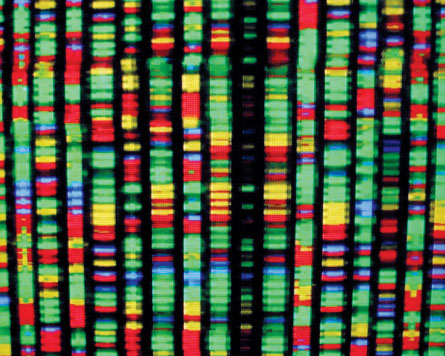90th Anniversary Issue: 2000s
Genomics and other highlights, 2000–2011

Reading genomes
When a private company and a government project both published the genetic instruction book for human beings in 2001, the text was “as striking for what we don’t see as for what we do,” Science News reported (2/17/01, p. 100). Only a third as many genes were found as had been expected (color-coded DNA analysis shown). Upon closer readings over the last decade, the surprises kept coming. Scientists have shown that different individuals have “much more human genetic variation than scientists had expected” (9/8/07, p. 147) and discovered that tiny snippets of RNA keep cells healthy. Frisky Neandertals may have even left “a little relic of the Stone Age in [human] DNA” (6/5/10, p. 5). But as the list of people and other creatures whose genetic blueprints have been deciphered grows, fundamental questions remain—including precisely how many genes people have (“no one really knows”) and which ones actually do something important (11/6/10, p. 5). — Devin Powell
Note: N indicates findings that went on to win a Nobel Prize.
2000 | Mars view Analyses of images taken by NASA’s Mars Global Surveyor spacecraft suggest that water may have recently gushed up from below the surface (7/1/00, p. 5).
2000 | Tau neutrino Physicists provide the first direct evidence of the tau neutrino (7/29/00, p. 68).
2001 | Human genome Two projects report deciphering the genetic blueprints of humans; although scientists had expected to find 100,000 genes, the efforts turn up only about one-third that many (2/17/01, p. 100).
2001 | Photon fixative Physicists report getting light pulses to stand still, without destroying the photons (1/27/01, p. 52).
2002 | Early ancestor Anthropologists working in Chad describe a fossil skull more than 6 million years old of Sahelanthropus tchadensis, which may be the oldest known human ancestral species (7/13/02, p. 19).
2002 | RNA rise Researchers find increasing numbers of genes that contain instructions to make RNA rather than proteins (1/12/02, p. 24).
2002 | Age of universe Astronomers put the age range of the universe at between 13 billion and 14 billion years (5/4/02, p. 277).
2003 | SARS fears A deadly viral pneumonia that emerged in China, called SARS for severe acute respiratory syndrome, begins spreading around the globe (3/29/03, p. 198; 4/26/03, p. 262).
2004 | Hobbits Remains of a small humanlike species that lived as late as 18,000 years ago, nicknamed hobbits, are reported on the Indonesian island of Flores (10/30/04, p. 275).
2005 | Quark-gluon plasma Physicists create a quark-gluon plasma, the primordial matter of the young universe; surprisingly, it is a liquid, not a gas (4/23/05, p. 259).
2006 | Pluto demoted After a rancorous debate, astronomers vote to take away Pluto’s planetary status (8/19/06, p. 115; 9/2/06, p. 149).
2006 | Dark matter Researchers report direct detection of dark matter’s presence in space (8/26/06, p. 131).
2007 | Cell switcheroo Biologists turn human skin cells into stem cells, without embryos (11/24/07, p. 323).
2008 | Mars water A Mars lander definitively confirms the presence of water on Mars, after the rover “touched and tasted ice” (8/30/08, p. 11).
2009 | MicroRNAs A tumor suppressor protein turns out to have a previously unrecognized function: helping to slice stretches of RNA into regulatory molecules called microRNAs (8/15/09, p. 8).
2009 | All about Ardi A 4.4-million-year-old partial female skeleton found in Africa offers the closest look yet at Ardipithecus ramidus, right (10/24/09, p. 9).
2010 | BP oil spill The biggest oil spill in the history of the United States dumps a mixture of crude oil and natural gas into the Gulf of Mexico for five months (7/3/10, p. 5; 9/11/10, p. 5; 10/9/10, p. 10).
2010 | Neandertal liaisons A project sequencing the Neandertal genetic instruction book turns up evidence of prehistoric interbreeding between that species and humans (6/5/10, p. 5).
2011 | Tohoku-oki quake A magnitude 9.0 earthquake in Japan and the tsunami it spawned kill more than 15,000 people and trigger the worst nuclear disaster since Chernobyl (4/9/11, p. 5).
2011 | Sea level rise
North Carolina sediment cores reveal that sea levels began rising precipitously in the late 19th century, a trend attributed to climate change (7/16/11, p. 13).
Ninety years of spreading the science news
Through the years, Science News has found a range of creative ways to bring the latest discoveries of science to the public.
1932 SNL offers “an experimental series of science addresses recorded phonographically by eminent scientists” on long-playing records (2/20/32.p. 112) A set of seven records with pictures of the speakers sells for $3 postage paid (3/5/32, p. 148).
1935–1958 Science Service (publisher of SNL) produces radio programs for CBS radio. The “Adventures in Science” series from 1939–1958 features interviews with scientists by Watson Davis, SNL editor.
The December 26, 1953, “Review of Science” broadcast highlights Watson and Crick’s discovery of DNA’s structure. Listen now:
“The Future of Electronics,” broadcast July 19, 1952, discusses promising new “memory tubes” for computers. Listen now:
1943 An overseas pocket-sized edition of Science News Letter ships out to troops during World War II (11/20/43).
1954 A monthly edition of SNL is offered to carry “the news of science to the non-English speaking areas of the world.” Called Scientia International, the magazine is printed in an “international auxiliary language” called Interlingua (akin to Esperanto): “In other countries there is no journal like Science News Letter. But now you can supply them with one in a language which is not their native tongue but which they can read with utter ease” (2/20/54, p. 125).

2011 Science News Prime, an interactive tablet publication for the iPad (shown at right), goes on sale in the iTunes app store. — Erika Engelhaupt







